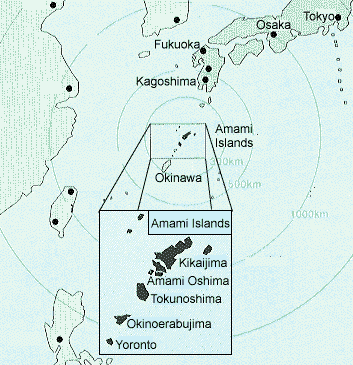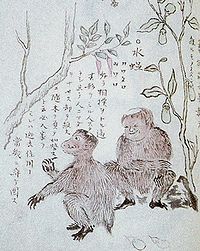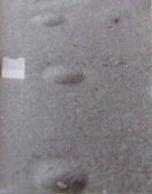
October 3, 2012
On the island of Amami Oshima (Amami big island), there have long been stories of a hairy, monkey-like creature known as the Kenmun. Let us now take a look into these tropical southern islands of Japan, and the mysteries they hide.

Amami Oshima is the largest island in the Amami chain of islands, in the Northern part of the Ryukyu archipelago. The island is part of Kagoshima prefecture rather than Okinawa prefecture, which comprises the Southern part of the archipelago. It is 274 square miles in area, with mountainous, forested terrain.

The Amami rabbit.
Although the island is home to several unique species, Amami Oshima is notable in zoology for being the home of the endemic Amami black rabbit (Pentalagus furnessi), shown above, which demonstrates apparent hare ancestral trait. This rabbit is found on Amami, Tokunoshima, and no where else in the world.
The Kenmun, also known as the Kunmon, Kunmu, and Nebuzawa, is said to be around 1 to 1.3 meters tall, about the size of a 5 or 6 year old child. It is covered in kinky, red or black hair, that looks mussed and dirty. The Kenmun has a face that is most often described as being like that of a monkey, but also sometimes as dog-like. It is a nocturnal animal, with eyes that glow red in the dark when light catches them. The creature’s arms are disproportionately long compared to the legs, and it is said to be an agile and powerful climber.
The Kenmun is often thought of as another type of Kappa (a sort of Japanese water imp), and old folkloric stories on the animal even describe it as having a cup-like thing on its head, just like the Kappa.

The Kenmun is said to be highly arboreal, making its home primarily in banyan trees, yet it is also a good swimmer, and is thought to prefer habitat near water such as rivers or the sea. It’s favorite foods are said to be fish, crab, and octopus, as well as shellfish and snails. Indeed it is thought that a sure sign of a Kenmun’s tree is the shellfish and snail shells littering the area under it. The creature is said to be particularly fond of fish eyes, which it will pop out and eat with relish.

A prominent feature of the Kenmun is its powerful stench, variously described as smelling like goat, horse, and rotting yams. The smell is believed to instill great fear in animals that come into contact with it, and there have been modern accounts of this. For instance, in 1973, a rancher reported that as he moved his cows to pasture, they suddenly became spooked and refused to move. It was strange since they had never acted this way before. The curious rancher took a look around and didn’t see anything unusual, but he became aware of a thick, pungent stench in the air. It was not until the smell passed that the cows finally regained their composure. Similar effects have often been reported on horses and dogs.
Although mostly considered as harmless, the Kenmun has a somewhat bad reputation nevertheless. In folklore, it was thought to be a trickster as well as a bit headstrong, known to challenge travelers to wrestling matches. In more modern reports, the creatures are said to steal fish or bait from fishermen, and indeed Kenmun are most often seen by fisherman fishing at night.
Some more violent behavior includes shrieking at passerby and hurling rocks or stones. There have even been accounts of homes being besieged by rock throwing Kenmun. One man told of seeing a small, dark form sitting alone on the beach one evening. When he called out to it, the figure suddenly whirled around in surprise and the man was astonished to see that it was a hairy creature like a small ape. This creature proceeded to start throwing rocks at the terrified man, even chasing him to his nearby home, where it continued to pelt the dwelling with rocks for some time before leaving the area.
Although the Kenmun has long been sighted by islanders, physical evidence has mostly taken the form of trees with a disproportionate amount of discarded shells under them, and footprints that turn up from time to time.

In November, 1986, a man by the name of Isamu Satoyama photographed a series of strange tracks in the sand on a secluded beach. The tracks went on for 500 meters, and measured 10 cm by 30 cm in diameter. Similar trackways have been found time to time in areas the Kenmun are said to inhabit, most often in sand but not always. There was even a plaster cast made of one such print, although it proved to be inconclusive. In more recent years, very few tracks have been found and eyewitness reports are rare.
The Kenmun is not the only type of creature like this to be found in the Ryukyu islands. It is very similar to another type of mysterious creature known as the Kijimuna, which is said to live in the more Southern Okinawa prefecture.
What could the Kenmun possibly be? A new type of primate? A hominid or proto-pygmy of some sort? Is this some sort of subspecies of yet another cryptid, the Kappa? Are they a figment of the imagination? The lack of any new sightings or evidence suggest that if these things ever existed, then they may well have already gone extinct or are close to it. If that is the case, then perhaps we will never know what they were.
About mystery_man
Filed under Cryptotourism, Cryptozoology, Evidence, Eyewitness Accounts, Mystery Man's Menagerie, Proto-Pygmies